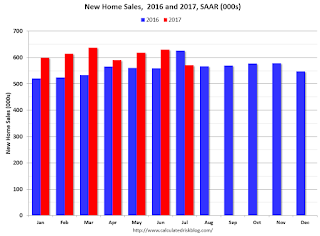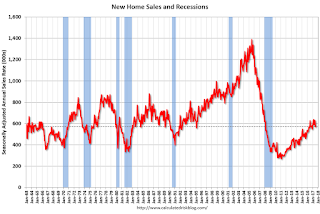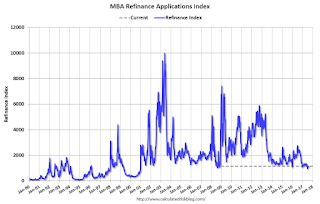by Calculated Risk on 8/23/2017 08:50:00 PM
Wednesday, August 23, 2017
Thursday: Existing Home Sales, Unemployment Claims, Jackson Hole Economic Symposium
Thursday:
• At 8:30 AM ET, The initial weekly unemployment claims report will be released. The consensus is for 236 thousand initial claims, up from 232 thousand the previous week.
• At 10:00 AM, Existing Home Sales for July from the National Association of Realtors (NAR). The consensus is for 5.57 million SAAR, up from 5.52 million in June. Take the under!
• At 11:00 AM, the Kansas City Fed manufacturing survey for August.
• Three days (Thursday, Friday and Saturday): The 2017 Jackson Hole Economic Symposium, "Fostering a Dynamic Global Economy, will take place Aug. 24-26, 2017. (The program will be available at 6 p.m., MT, Aug. 24, 2017)."
Philly Fed: State Coincident Indexes increased in 33 states in July
by Calculated Risk on 8/23/2017 05:32:00 PM
From the Philly Fed:
The Federal Reserve Bank of Philadelphia has released the coincident indexes for the 50 states for July 2017. Over the past three months, the indexes increased in 41 states and decreased in nine, for a three-month diffusion index of 64. In the past month, the indexes increased in 33 states, decreased in 15, and remained stable in two, for a one-month diffusion index of 36.Note: These are coincident indexes constructed from state employment data. An explanation from the Philly Fed:
emphasis added
The coincident indexes combine four state-level indicators to summarize current economic conditions in a single statistic. The four state-level variables in each coincident index are nonfarm payroll employment, average hours worked in manufacturing by production workers, the unemployment rate, and wage and salary disbursements deflated by the consumer price index (U.S. city average). The trend for each state’s index is set to the trend of its gross domestic product (GDP), so long-term growth in the state’s index matches long-term growth in its GDP.
 Click on graph for larger image.
Click on graph for larger image.This is a graph is of the number of states with one month increasing activity according to the Philly Fed. This graph includes states with minor increases (the Philly Fed lists as unchanged).
In July, 34 states had increasing activity (including minor increases).
The downturn in 2015 and 2016, in the number of states increasing, was mostly related to the decline in oil prices.
The reason for the recent sharp decrease in the number of states with increasing activity is unclear - and might be revised away.
 Here is a map of the three month change in the Philly Fed state coincident indicators. This map was all red during the worst of the recession, and almost all green now.
Here is a map of the three month change in the Philly Fed state coincident indicators. This map was all red during the worst of the recession, and almost all green now.Source: Philly Fed. Note: For complaints about red / green issues, please contact the Philly Fed.
A few Comments on July New Home Sales
by Calculated Risk on 8/23/2017 02:44:00 PM
New home sales for July were reported at 571,000 on a seasonally adjusted annual rate basis (SAAR). This was well below the consensus forecast, however the three previous months were revised up sharply. Overall this was decent report.
Sales were down 8.9% year-over-year in July.
Earlier: New Home Sales decrease to 571,000 Annual Rate in July.

This graph shows new home sales for 2016 and 2017 by month (Seasonally Adjusted Annual Rate). Sales were down 8.9% year-over-year in July.
Note that sales in July 2016 were strong, so this was a difficult year-over-year comparison.
For the first seven months of 2017, new home sales are up 9.2% compared to the same period in 2016.
This was a strong year-over-year increase through July.
AIA: Architecture Billings Index "growth moderates" in July
by Calculated Risk on 8/23/2017 11:47:00 AM
Note: This index is a leading indicator primarily for new Commercial Real Estate (CRE) investment.
From the AIA: Architecture Billings Index growth moderates
For the sixth consecutive month, architecture firms reported increasing demand for design services as reflected in the July Architecture Billings Index (ABI). As a leading economic indicator of construction activity, the ABI reflects the approximate nine to twelve month lead time between architecture billings and construction spending. The American Institute of Architects (AIA) reported the July ABI score was 51.9, down from a score of 54.2 in the previous month. This score still reflects an increase in design services (any score above 50 indicates an increase in billings). The new projects inquiry index was 59.5, up from a reading of 58.6 the previous month, while the new design contracts index increased from 53.7 to 56.4.
“The July figures show the continuation of healthy trends in the construction sector of our economy,” said AIA Chief Economist, Kermit Baker, Hon. AIA, PhD. “In addition to the balanced increases in design billings across all major regions and construction sectors, the strong gains in new project work coming into architecture firms points to future growth in design and construction activity over coming quarters.”
...
• Regional averages: South (53.8), Midwest (53.8), Northeast (53.6), West (50.9)
• Sector index breakdown: multi-family residential (55.8), commercial / industrial (55.4), institutional (52.0), mixed practice (48.4)
emphasis added
 Click on graph for larger image.
Click on graph for larger image.This graph shows the Architecture Billings Index since 1996. The index was at 51.9 in July, up from 54.2 the previous month. Anything above 50 indicates expansion in demand for architects' services.
Note: This includes commercial and industrial facilities like hotels and office buildings, multi-family residential, as well as schools, hospitals and other institutions.
According to the AIA, there is an "approximate nine to twelve month lag time between architecture billings and construction spending" on non-residential construction. This index was positive in 9 of the last 12 months, suggesting a further increase in CRE investment in 2017 and early 2018.
New Home Sales decrease to 571,000 Annual Rate in July
by Calculated Risk on 8/23/2017 10:12:00 AM
The Census Bureau reports New Home Sales in July were at a seasonally adjusted annual rate (SAAR) of 571 thousand.
The previous three months were revised up solidly.
"Sales of new single-family houses in July 2017 were at a seasonally adjusted annual rate of 571,000, according to estimates released jointly today by the U.S. Census Bureau and the Department of Housing and Urban Development. This is 9.4 percent below the revised June rate of 630,000 and is 8.9 percent below the July 2016 estimate of 627,000."
emphasis added
 Click on graph for larger image.
Click on graph for larger image.The first graph shows New Home Sales vs. recessions since 1963. The dashed line is the current sales rate.
Even with the increase in sales over the last several years, new home sales are still somewhat low historically.
The second graph shows New Home Months of Supply.
 The months of supply increased in July to 5.8 months from 5.2 month in June.
The months of supply increased in July to 5.8 months from 5.2 month in June. The all time record was 12.1 months of supply in January 2009.
This is in the normal range (less than 6 months supply is normal).
"The seasonally-adjusted estimate of new houses for sale at the end of July was 276,000. This represents a supply of 5.8 months at the current sales rate."
 On inventory, according to the Census Bureau:
On inventory, according to the Census Bureau: "A house is considered for sale when a permit to build has been issued in permit-issuing places or work has begun on the footings or foundation in nonpermit areas and a sales contract has not been signed nor a deposit accepted."Starting in 1973 the Census Bureau broke this down into three categories: Not Started, Under Construction, and Completed.
The third graph shows the three categories of inventory starting in 1973.
The inventory of completed homes for sale is still low, and the combined total of completed and under construction is also low.
 The last graph shows sales NSA (monthly sales, not seasonally adjusted annual rate).
The last graph shows sales NSA (monthly sales, not seasonally adjusted annual rate).In July 2017 (red column), 49 thousand new homes were sold (NSA). Last year, 54 thousand homes were sold in July.
The all time high for July was 117 thousand in 2005, and the all time low for June was 26 thousand in 2010.
This was below expectations of 610,000 sales SAAR, however the previous months were revised up solidly. I'll have more later today.
MBA: Mortgage Applications Decrease in Latest Weekly Survey
by Calculated Risk on 8/23/2017 07:00:00 AM
From the MBA: Mortgage Applications Decrease in Latest MBA Weekly Survey
Mortgage applications decreased 0.5 percent from one week earlier, according to data from the Mortgage Bankers Association’s (MBA) Weekly Mortgage Applications Survey for the week ending August 18, 2017.
... The Refinance Index increased 0.3 percent from the previous week. The seasonally adjusted Purchase Index decreased 2 percent from one week earlier. The unadjusted Purchase Index decreased 3 percent compared with the previous week and was 9 percent higher than the same week one year ago. ...
The average contract interest rate for 30-year fixed-rate mortgages with conforming loan balances ($424,100 or less) remained unchanged from the week prior at 4.12 percent, with points increasing to 0.39 from 0.38 (including the origination fee) for 80 percent loan-to-value ratio (LTV) loans.
emphasis added
 Click on graph for larger image.
Click on graph for larger image.The first graph shows the refinance index since 1990.
Refinance activity will not pick up significantly unless mortgage rates fall well below 4%.
 The second graph shows the MBA mortgage purchase index.
The second graph shows the MBA mortgage purchase index. According to the MBA, purchase activity is up 9% year-over-year.
Tuesday, August 22, 2017
Wednesday: New Home Sales
by Calculated Risk on 8/22/2017 05:39:00 PM
Wednesday:
• At 7:00 AM ET, The Mortgage Bankers Association (MBA) will release the results for the mortgage purchase applications index.
• At 10:00 AM, New Home Sales for July from the Census Bureau. The consensus is for 610 thousand SAAR, unchanged from 610 thousand in June.
• During the day: The AIA's Architecture Billings Index for July (a leading indicator for commercial real estate).
Chemical Activity Barometer Shows Modest Slowing in August
by Calculated Risk on 8/22/2017 11:45:00 AM
Note: This appears to be a leading indicator for industrial production.
From the American Chemistry Council: Chemical Activity Barometer Shows Modest Slowing
The Chemical Activity Barometer (CAB), a leading economic indicator created by the American Chemistry Council (ACC), remained unchanged from July, continuing a modest deceleration of growth. The flat reading follows a 0.1 percent increase in July and a flat reading in June. Compared to a year earlier, the CAB is up 3.2 percent year-over-year, an easing from recent year-over-year gains. All data is measured on a three-month moving average (3MMA).
On a year-over-year basis, the unadjusted CAB is up 3.0 percent, also an easing from the previous six months.
...
Applying the CAB back to 1912, it has been shown to provide a lead of two to fourteen months, with an average lead of eight months at cycle peaks as determined by the National Bureau of Economic Research. The median lead was also eight months. At business cycle troughs, the CAB leads by one to seven months, with an average lead of four months. The median lead was three months. The CAB is rebased to the average lead (in months) of an average 100 in the base year (the year 2012 was used) of a reference time series. The latter is the Federal Reserve’s Industrial Production Index.
emphasis added
 Click on graph for larger image.
Click on graph for larger image.This graph shows the year-over-year change in the 3-month moving average for the Chemical Activity Barometer compared to Industrial Production. It does appear that CAB (red) generally leads Industrial Production (blue).
CAB increased solidly in early 2017 suggesting an increase in Industrial Production, however, the year-over-year increase in the CAB has slowed recently.
Richmond Fed: "Manufacturing Activity in August Remained Little Changed from July"
by Calculated Risk on 8/22/2017 10:04:00 AM
From the Richmond Fed: Reports on Fifth District Manufacturing Activity in August Remained Little Changed from July
Reports on Fifth District manufacturing activity were largely unchanged in August, according to the latest survey by the Federal Reserve Bank of Richmond. The composite index remained at 14 in August, with an increase in the employment index offsetting a decrease in the shipments index and a very slight decline in the new orders metric. Although the employment index rose from 10 to 17 in August, other measures of labor market activity — wages and average workweek — were largely unchanged.This suggests solid growth in August.
emphasis added
Monday, August 21, 2017
"Mortgage Rates Steady at 2017 Lows"
by Calculated Risk on 8/21/2017 05:11:00 PM
From Matthew Graham at Mortgage News Daily: Mortgage Rates Steady at 2017 Lows
Mortgage rates held steady to start the new week. This keeps them in line with the best levels since November 2016. There were no interesting developments in financial markets or in terms of economic data today. ...Tuesday:
3.875% remains the most prevalently-quoted conventional 30yr fixed rate for top tier scenarios, although quite a few lenders remain at 4.00%.
• At 9:00 AM ET, FHFA House Price Index for June 2017. This was originally a GSE only repeat sales, however there is also an expanded index.
• At 10:00 AM, Richmond Fed Survey of Manufacturing Activity for August.
• Also expected at 10:00 AM (not confirmed), Q2 MBA National Delinquency Survey.


